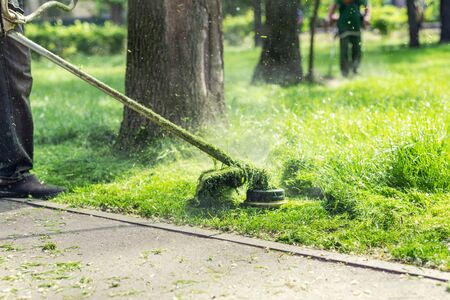Introduction: Why Proper Mower Maintenance Matters
If you’re a British homeowner, chances are you cherish a well-kept lawn as much as the next person. The humble petrol lawn mower remains a staple in many UK sheds and garages, but its reliability and performance depend heavily on how well it’s maintained. Keeping your mower in good nick isn’t just about making sure it starts each spring; it’s about maximising efficiency, ensuring a healthier lawn, and getting the best value out of your investment. A properly maintained mower cuts more cleanly, uses less fuel, and is less likely to leave your grass looking ragged or scalped. Regular upkeep also extends the life of your machine, helping you avoid untimely breakdowns and potentially costly repairs. In this guide, we’ll walk you through everything you need to know to keep your petrol mower running smoothly season after season—because a tidy lawn starts with a well-cared-for mower.
2. Essential Tools and Safety Precautions
Before embarking on any maintenance of your petrol lawn mower, it’s important for every British homeowner to gather the right tools and take necessary safety steps. Using the correct equipment not only makes each task more manageable but also ensures both your safety and that of your machine.
Basic Tools Checklist
The following table outlines the essential tools you’ll need for routine maintenance:
| Tool | Purpose |
|---|---|
| Socket set or spanner | Removing bolts, spark plugs, and blade fastenings |
| Spark plug wrench | Safely removing and fitting spark plugs |
| Screwdrivers (flathead & Phillips) | Opening covers, adjusting screws |
| Cleaning brush/old toothbrush | Clearing grass clippings and dirt from components |
| Oil drain pan | Catching used engine oil during changes |
| Funnel | Pours oil or fuel cleanly without spills |
| Gloves (heavy-duty) | Protects hands from sharp edges and chemicals |
Important Safety Precautions
- Disconnect the Spark Plug: Always disconnect the spark plug lead before carrying out any checks or repairs. This simple step helps prevent accidental engine start-up.
- Work in a Well-Ventilated Area: Carry out maintenance outdoors or in a garage with open doors to avoid inhaling fumes.
- Avoid Hot Surfaces: Allow the engine to cool completely before touching or opening any part of the mower to prevent burns.
- Wear Appropriate Clothing: Avoid loose clothing and always wear sturdy gloves and closed-toe shoes for protection.
- Use Approved Containers: Store petrol in suitable jerry cans and handle with care to minimise spillages or fire hazards.
A Note on Environmental Responsibility
If you’re disposing of old oil or petrol, always use your local council’s recycling facilities. Never pour these substances down the drain or onto the ground—British environmental regulations are strict for good reason, protecting both wildlife and water sources.
![]()
3. Pre-Season Checks: Preparing Your Mower for Spring
As the first signs of spring brighten up British gardens, it’s time to wake your petrol lawn mower from its winter hibernation. Carrying out thorough pre-season checks is essential for a reliable start and a tidy lawn. Here’s a step-by-step guide tailored for UK homeowners, ensuring your machine is fit for purpose before the grass starts growing in earnest.
Inspect and Replace Engine Oil
Start by checking the engine oil level. Place your mower on a flat surface, remove the dipstick, wipe it clean, then reinsert and check the level again. If the oil looks dark or sludgy, drain it completely (consult your manual for the correct procedure) and refill with fresh oil recommended for your model. Regular oil changes prevent engine wear and keep things running smoothly throughout the mowing season.
Spark Plug Service
The spark plug is crucial for easy starting and efficient running. Remove the spark plug using a socket spanner, inspect it for carbon build-up or corrosion, and gently clean it with a wire brush if necessary. If you notice worn electrodes or persistent fouling, replace it with a new plug—making sure to match the specifications in your owner’s manual. Refit and tighten securely but avoid over-tightening.
Air Filter Cleaning or Replacement
A clogged air filter can choke your engine, reducing performance and increasing fuel consumption. Locate the filter cover (usually secured by clips or screws), remove the filter, and check its condition. For foam filters, wash in warm soapy water, rinse thoroughly, dry completely, and lightly oil before refitting. Paper filters should be tapped gently to dislodge dust or replaced if very dirty. Never operate your mower without an air filter in place.
Check Fuel System
If there’s any old petrol left in the tank from last season, drain it safely—stale fuel can cause starting problems and damage the carburettor. Refill with fresh unleaded petrol (E10 is standard in the UK). Inspect fuel lines for cracks or leaks and replace as needed.
Blade Condition & Safety Check
Before reconnecting the spark plug, tip your mower carefully (always following manufacturer guidance), and inspect the blade for nicks or dull edges. A sharp blade gives a cleaner cut and healthier grass—sharpen or replace as necessary. Check all fixings are tight and that no debris is lodged underneath.
Final Steps
Finally, check tyre pressures (if applicable), cables, levers, and overall chassis condition. Once satisfied everything’s in order, reconnect the spark plug lead. With these pre-season checks complete, your petrol mower will be ready to tackle another British summer—and help you keep that quintessentially neat lawn all season long.
4. Routine Maintenance: Keeping Your Mower Running Smoothly
Consistent upkeep is the backbone of reliable performance for your petrol lawn mower. British homeowners often find that a few regular checks can dramatically extend the life and efficiency of their machines, making mowing less of a chore and more of a pleasure. Below, you’ll find key weekly or monthly tasks that should be part of your routine.
Weekly and Monthly Maintenance Checklist
| Task | Frequency | Why It Matters (British Perspective) |
|---|---|---|
| Blade Sharpening | Monthly (or as needed) | A sharp blade ensures a clean cut, preventing damage to grass especially in damp British conditions. |
| Grass Box Cleaning | After every use | Prevents mould and unpleasant odours, which are common in the UK’s moist climate. |
| Check for Leaks (Oil/Fuel) | Weekly | Catches issues early, avoiding messy spills on patios or lawns. |
| Tighten Loose Fittings | Monthly | Vibration from use can loosen bolts; keeping everything snug prevents breakdowns during peak mowing season. |
| Clean Air Filter | Monthly (more often in dry spells) | A clear air filter keeps the engine running smoothly—especially important with pollen-heavy British summers. |
Tips for Effective Routine Care
- Treat blade sharpening as a safety-first job: Always disconnect the spark plug before handling blades. You can take them to a local garden centre if you’re unsure about DIY sharpening.
- Use mild soapy water for cleaning: After each mow, remove clippings from the grass box and undercarriage to prevent rot and rust—two common foes in the UK’s wet weather.
- Tighten fittings with appropriate tools: Keep a set of spanners or socket wrenches handy in your shed. A quick check once a month can save you from unexpected breakdowns mid-mow.
- Regular inspection for leaks: Pay special attention to seals and gaskets. The smell of petrol or an oily patch under your mower is your cue to investigate further before it becomes a bigger headache.
The Value of Consistency
A little effort on a regular basis goes a long way. Establishing these habits not only preserves your investment but also means you’re less likely to be caught out by mechanical mishaps just when the grass needs taming. For many UK households, this is the quiet secret behind those neat stripes and healthy lawns you see up and down the country.
5. End-of-Season Care: Getting Ready for Winter Storage
As autumn draws to a close and the British weather turns colder, it’s essential to prepare your petrol lawn mower for winter hibernation. Proper end-of-season care not only ensures a smooth start come spring but also extends the lifespan of your mower. Here’s a step-by-step guide tailored for UK homeowners.
Draining the Fuel
Petrol left in the tank over winter can degrade and clog the carburettor, leading to frustrating starting problems next season. To avoid this, run the engine until it stops naturally, using up any remaining fuel. Alternatively, use a hand pump or siphon to drain the tank completely, then run the engine briefly to empty any fuel from the lines. Dispose of old petrol responsibly at your local recycling centre—never pour it down drains or onto the ground.
Thorough Cleaning
Grass clippings and soil stuck underneath the deck can harbour moisture and cause rust during damp British winters. First, disconnect the spark plug for safety. Use a stiff brush or plastic scraper to remove debris from under the deck and around the blades. Wipe down all external surfaces with a damp cloth and mild detergent. If possible, lightly oil metal parts to fend off corrosion, paying special attention to exposed bolts and moving joints.
Proper Storage
Store your mower in a dry, sheltered location such as a garden shed or garage—never outdoors where frost and rain can wreak havoc. If space is tight, consider storing it upright if your model allows (check your manual first). Covering your mower with a breathable dust sheet helps keep it clean while preventing condensation build-up. For added peace of mind, remove the battery (if fitted) and store it indoors in a cool, dry place.
Final Checks Before Tucking Away
Check that all nuts and bolts are secure, and ensure no tools or loose parts are left inside the grass box or on the deck. Finally, jot down any issues encountered during the season so you can address them before first use in spring—this small habit saves time and hassle down the line.
A Little Preparation Goes a Long Way
Following these end-of-season steps will help your petrol lawn mower withstand the unpredictable British winter and guarantee a reliable performance when lawns need their first trim come March.
6. Troubleshooting Common Issues
Advice for Identifying and Fixing Typical British Petrol Mower Problems
No matter how diligent you are with maintenance, petrol lawn mowers can develop the odd niggle, especially with the unpredictable British weather and mowing conditions. Here’s a concise guide to recognising and resolving some of the most common issues faced by UK homeowners.
Starting Difficulties
If your mower refuses to start or splutters into life, first check the basics: Is there fresh unleaded petrol in the tank? Stale fuel is a frequent culprit after winter storage—always drain old petrol and refill. Examine the spark plug; if it’s sooty or corroded, clean or replace it with a compatible model. Make sure the air filter isn’t clogged with grass clippings or dust; a quick clean or replacement works wonders. For persistent problems, inspect the carburettor for blockages and consider seeking help from a local service centre.
Uneven Cutting
An uneven finish is often down to blunt or damaged blades—a surprisingly common occurrence after hitting a hidden stone or tree root in a typical British garden. Remove and sharpen the blade regularly, or replace it if it’s badly nicked. Also, ensure your mower’s wheels are set at an even height and that none are loose or wobbly. Wet grass can also clog up the underside of the deck, causing scalping or missed patches, so always mow when grass is dry if possible and clear out any build-up after use.
Excessive Smoke
Seeing smoke billowing from your mower can be alarming. White smoke usually means oil has leaked onto hot engine parts—often because the mower was tilted incorrectly during cleaning or blade changes. Check oil levels and make sure you’re using the correct grade for your machine (consult your manual if unsure). Blue or black smoke may indicate overfilling, burning oil, or more serious engine trouble, in which case it’s wise to consult a qualified mechanic rather than risk further damage.
General Troubleshooting Tips
Keep a basic toolkit handy: spanners, screwdrivers, spare spark plugs, and a brush for cleaning. Always disconnect the spark plug before working on any part of the mower for safety. If you’re ever unsure—or if problems persist—don’t hesitate to contact your local garden machinery shop; many offer friendly advice tailored to British models and conditions.


